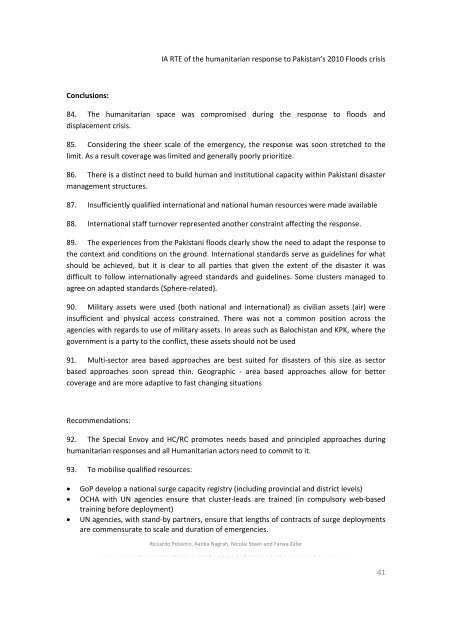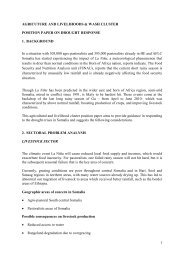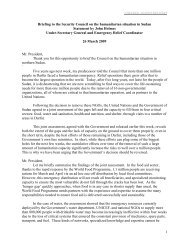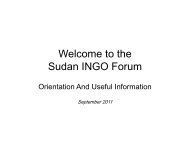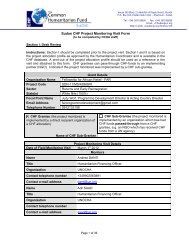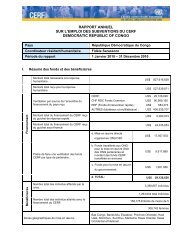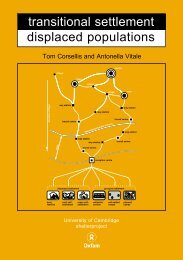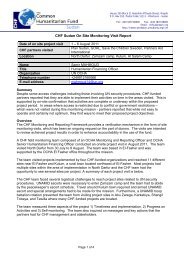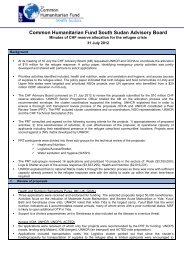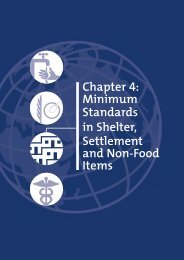Inter-Agency Real Time Evaluation of the Humanitarian ... - OCHANet
Inter-Agency Real Time Evaluation of the Humanitarian ... - OCHANet
Inter-Agency Real Time Evaluation of the Humanitarian ... - OCHANet
You also want an ePaper? Increase the reach of your titles
YUMPU automatically turns print PDFs into web optimized ePapers that Google loves.
Conclusions:<br />
IA RTE <strong>of</strong> <strong>the</strong> humanitarian response to Pakistan’s 2010 Floods crisis<br />
84. The humanitarian space was compromised during <strong>the</strong> response to floods and<br />
displacement crisis.<br />
85. Considering <strong>the</strong> sheer scale <strong>of</strong> <strong>the</strong> emergency, <strong>the</strong> response was soon stretched to <strong>the</strong><br />
limit. As a result coverage was limited and generally poorly prioritize.<br />
86. There is a distinct need to build human and institutional capacity within Pakistani disaster<br />
management structures.<br />
87. Insufficiently qualified international and national human resources were made available<br />
88. <strong>Inter</strong>national staff turnover represented ano<strong>the</strong>r constraint affecting <strong>the</strong> response.<br />
89. The experiences from <strong>the</strong> Pakistani floods clearly show <strong>the</strong> need to adapt <strong>the</strong> response to<br />
<strong>the</strong> context and conditions on <strong>the</strong> ground. <strong>Inter</strong>national standards serve as guidelines for what<br />
should be achieved, but it is clear to all parties that given <strong>the</strong> extent <strong>of</strong> <strong>the</strong> disaster it was<br />
difficult to follow internationally agreed standards and guidelines. Some clusters managed to<br />
agree on adapted standards (Sphere‐related).<br />
90. Military assets were used (both national and international) as civilian assets (air) were<br />
insufficient and physical access constrained. There was not a common position across <strong>the</strong><br />
agencies with regards to use <strong>of</strong> military assets. In areas such as Balochistan and KPK, where <strong>the</strong><br />
government is a party to <strong>the</strong> conflict, <strong>the</strong>se assets should not be used<br />
91. Multi‐sector area based approaches are best suited for disasters <strong>of</strong> this size as sector<br />
based approaches soon spread thin. Geographic ‐ area based approaches allow for better<br />
coverage and are more adaptive to fast changing situations<br />
Recommendations:<br />
92. The Special Envoy and HC/RC promotes needs based and principled approaches during<br />
humanitarian responses and all <strong>Humanitarian</strong> actors need to commit to it.<br />
93. To mobilise qualified resources:<br />
� GoP develop a national surge capacity registry (including provincial and district levels)<br />
� OCHA with UN agencies ensure that cluster‐leads are trained (in compulsory web‐based<br />
training before deployment)<br />
� UN agencies, with stand‐by partners, ensure that lengths <strong>of</strong> contracts <strong>of</strong> surge deployments<br />
are commensurate to scale and duration <strong>of</strong> emergencies.<br />
Riccardo Polastro, Aatika Nagrah, Nicolai Steen and Farwa Zafar<br />
41


